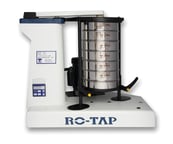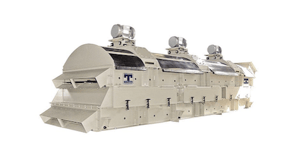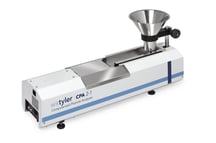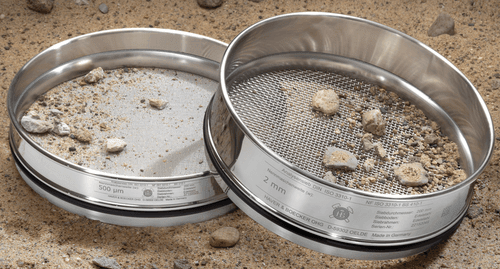4 Particle Analysis Instruments Used for Testing Aggregate
The aggregate industry is one of the most influential industries affecting everyday life. From the sidewalks we walk on to the roads we drive on to the buildings we shop in, the aggregate industry plays a significant role in making the world go round.
When leading an operation that involves the production of high-quality aggregate, you must incorporate a means of quality control that ensures a certain level of quality and consistency is met.
This is where particle analysis comes into play.
W.S. Tyler has been a pioneer of the particle analysis industry for over 150 years and can help enhance the quality control of your aggregate production process.
With that, this article will cover everything you need to know about particle analysis in the aggregate industry, define what aggregate is, explain why particle analysis is important to the industry, and provide insight into some of the equipment used to analyze the particle size of your material.
What Is Aggregate?
The term aggregate is commonly used to describe the sediment material used for most construction projects. Coming in a variety of shapes and sizes, aggregate is applied as a base layer for roads, and is often mixed within cement and asphalts.
By using aggregate, you can better control the level at which the cement/asphalt mixture contracts and expands, preventing cracking and warping. This is especially crucial when working on roads and bridges.
How Does Particle Analysis Affect the Aggregate Industry?
What makes particle analysis essential to the aggregate industry boils down to the safety guidelines the construction companies using aggregate must follow.
To explain, let’s use the cement pylons used for bridges as an example. Each piece of aggregate in the cement mixture that’s used to form the pylons need to be specific size and uniformity to guarantee it will maintain its form and shape.
For this reason, there are several ASTM and AASHTO standards written to guide you on how to crush aggregate, how to produce it, and what it should look like for any given application.
So what happens if particle analysis is omitted when producing aggregate?
Well, if particle analysis were absent from the aggregate industry, the lifespan of the project would be significantly shorter, and the reputation of the supplier would, in turn, be negatively impacted.
For example, it was previously stated that aggregate is often used as a base layer when constructing roads.
This layer of aggregate must be as flat as possible to ensure the road is safe for drivers and is built to last. If the aggregate did not undergo some form of particle analysis before it is used as a base layer of a new road, it would contain particle size variants that defy industry standards and not lay flat.
As a result, the road won’t be able to hold up over time, begin to form bumps and cracks, and need repairing.
What Aggregate Testing Equipment Is Used?
When it comes to particle analysis, four pieces of aggregate testing equipment are used throughout the industry: sieve shakers, screening machines, air jet sieves, and dynamic image analysis systems. We will now take an inside look at each one.
1. Sieve Shaker/Test Sieves
As most construction projects will facilitate public traffic, there are multiple safety guidelines that construction contractors must follow. To verify that a specific project complies with these guidelines, several pieces of documentation that reflect the quality of the aggregate being used must be submitted.

This is why sieve shakers and test sieves are the preferred tools for analyzing aggregate particles.
Sieve shakers, such as the W.S. Tyler RO-TAP®, have been used to conduct test sieve analysis since the 1930s and have been written to dozens of industry standards as reliable particle analysis tools. Because sieve shakers can be traced to known standards, the necessary quality control paperwork is easily accessible, and the audit process is simplified.
To learn more about how sieve shakers are used, refer to our article: How to Perform a Test Sieve Analysis.
2. Vibrating Screens
Vibrating screens carry out a similar version of particle analysis as sieve shakers but on a much larger scale. They allow for a particle separation range of 6 mesh to 325 mesh and employ one or multiple screen sections that separate particles in the same way as a test sieve stack.
 As it uses high-frequency vibrations to promote particle movement, blinding is reduced, allowing for enhanced productivity.
As it uses high-frequency vibrations to promote particle movement, blinding is reduced, allowing for enhanced productivity.
Each screen section is typically made from square,
ton-cap, or ty-rod mesh, and features a unique hook system on the sides that allows them to be retrieved from the equipment with ease while also being secure when the equipment is running.
To put it simply, screen machines are especially beneficial to the aggregate industry as they provide the most efficient means of testing several large-scale batches of material in one day, which a lot of operations require.
3. Air Jet Sieve
Air Jet Sieves, such as the NEXOPART® Air Jet Sieve e200 LS, is another particle analysis tool that has been gaining traction in the aggregate industry, specifically during the production of cement mixtures.
In fact, the Alpine unit has been written into several cement-related standards in recent years. 
This is due to its ability to analyze the finer particles that are used throughout cement mixtures and are hard to sieve using a Sieve Shaker. The Alpine uses a vacuum system to slam agglomerated material against its plexiglass lid to separate it and allow the material to pass through the mesh.
This vacuum system is what allows the Alpine to have so much success when working with cement mixtures.
To learn more about how an Alpine Air Jet works, review the NEXOPART® Air Jet Sieve e200 LS Product Guide.
4. Dynamic Image Analysis System
Dynamic image analysis systems, such as the NEXOPART® Computerized Particle Analyzer (CPA), provide the aggregate industry with a means of obtaining the same particle analysis as the other equipment in a digital format. They are also one of the fastest options on the market.
This is especially beneficial for the mining operations that handle the initial blast mining of the raw material. These operations typically employ a dynamic image analysis system as they have to test upwards to 20 samples each day.
 It should be noted that dynamic image analysis systems have yet to be reflected in industry standards. To comply with your particle analysis standards, it is recommended that you keep a stack of master sieves and test your material monthly.
It should be noted that dynamic image analysis systems have yet to be reflected in industry standards. To comply with your particle analysis standards, it is recommended that you keep a stack of master sieves and test your material monthly.
The correlation of these results will allow you to check the accuracy of your dynamic image analysis system.
Refer to How to Perform a Dynamic Image Analysis (Process, Maintenance, and Troubleshooting) to learn more about how a dynamic image analysis works.
Become a Particle Analysis Expert With Us
The aggregate industry is a vital asset to everyday life. Without it, the roads, bridges, buildings, and sidewalks that we encounter on a daily basis wouldn’t be as reliable and structured as they are.
To ensure a project's safety and longevity, the individual aggregate particles must be a certain size and have a specific uniformity. This is where particle analysis comes in.
To ensure your particle analysis process is efficient and effective, four main pieces of aggregate testing equipment can be used:
- Sieve Shakers are a staple in the particle analysis industry and are written into dozens of industry standards, making quality control audits virtually seamless.
- Screen machines provide a similar particle analysis experience to sieve shakers on a much larger scale and are ideal for operations that need an efficient means of testing a large amount of sample material at once.
- Air Jet Sieves employs a vacuum system that is unique to any other particle analysis instrument and allows cement manufacturers to test the fine particles that are difficult to test with a sieve shaker.
- Dynamic image analysis systems provide a digital means of conducting particle analysis. They stand out as one of the most time-efficient options on the market and are perfect for operations that test upwards of 20 samples a day.
Having worked in the particle analysis industry for over 140 years, W.S. Tyler has the experience needed to ensure the aggregate you produce contributes to the safety and longevity of the construction projects it’s applied to.
To learn more about the benefits particle analysis can bring to your operation, take a moment and review our Test Sieves, Sieve Shakers & Particle Analysis Equipment Product Guide.
Want all the latest industry trends and innovations sent directly to your inbox? Subscribe to our monthly newsletters today.
Additional Articles You May Find Helpful:
About Ronnie Brown
Ronnie is the Content Writer for W.S. Tyler and has four years of experience as a professional writer. He strives to expand his knowledge on all things particle analysis and woven wire mesh to leverage his exceptional writing and graphic design skills, creating a one-of-a-kind experience for customers.





